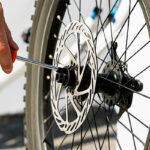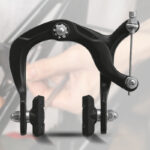Disc brakes have completely changed the bicycle industry in recent years by providing riders with improved stopping force, control and dependability. Knowing how disc brakes operate, and their advantages can greatly enhance your riding experience, regardless of your level of experience. We’ll explore the working of disc brakes, their benefits and the reasons behind their widespread adoption by riders across the globe in this comprehensive guide. We’ll also look at the products available from S.K. Aggarwal & Co (A Unit of Sprandom Pvt. Ltd.), one of the leading bicycle brakes manufacturer in India.
What Are Disc Brakes?
With disc brakes, the wheel hub is fixed with a metal disc or rotor, as part of the braking mechanism. The brake caliper presses the brake pads up against the rotor when the brake lever is depressed, slowing or stopping the bicycle. In contrast to conventional rim brakes, which exert force directly on the wheel rim, disc brakes provide more reliable stopping power, particularly under challenging circumstances.
There are two main types of disc brakes: mechanical and hydraulic.
- Mechanical Disc Brakes
The caliper, which clamps the brake pads onto the rotor, receives force from the brake lever via a cable. In general, mechanical disc brakes are less expensive and require less upkeep.
- Hydraulic Disc Brakes
This type of system uses hydraulic fluid to move the brake lever’s force to the caliper. Once properly adjusted, hydraulic disc brakes provide higher braking force, smoother modulation, and reduced maintenance.
Why Choose Disc Brakes?
The adoption of disc brakes has skyrocketed in recent years due to several key benefits:
- Better Stopping Power
Disc brakes provide more consistent and powerful braking, especially in wet or muddy conditions.
- Less Wheel Flex
They allow for the use of lighter wheels since the braking force is applied to the rotor rather than the rim, reducing the risk of wheel deformation.
- Improved Heat Dissipation
Disc brakes dissipate heat more effectively, preventing brake fade during prolonged use.
- Less Rim Wear
With disc brakes, the rims experience less wear, extending their lifespan.
- Versatility
They perform well in various conditions, making them suitable for mountain biking, road cycling, and touring.
- Adjustable Brake Feel
Many disc brake systems allow for adjustments to the braking feel, catering to personal preferences.
The Mechanics of Disc Brakes
Comprehending the fundamental principles of disc brakes might facilitate your appreciation of their efficacy and efficiency. This is how they function:
- Brake Lever
In mechanical systems, a cable is activated when the brake lever is squeezed; in hydraulic systems, hydraulic fluid is activated.
- Caliper
When the brake lever is engaged, the caliper holds the brake pads in place and applies pressure to clamp them onto the rotor.
- Brake Pads
The friction materials used in the brake pad’s construction press against the bike’s rotor to produce the necessary friction for the bike to slow down or stop.
- Rotor
A metal disc that is fastened to the wheel hub is the rotor. It is the surface that the brake pads clamp onto to provide braking force, and it rotates with the wheel.
Maintenance Tips for Disc Brakes
It’s essential to do routine maintenance on your disc brakes to guarantee optimal performance. To ensure that your disc brakes are in optimal condition, follow these tips:
- Examine and swap out the brake pads
Regularly inspect your brake pads for signs of wear. If they appear too thin, replace them immediately to maintain effective braking.
- Dust off the rotors
The efficiency of the brakes can be decreased by dirt, oil, and debris building up on the rotors. Rotor cleaning should be done on a regular basis using isopropyl alcohol and a clean towel.
- If your brakes are hydraulic, check the brake fluid
When using hydraulic disc brakes, make sure the brake fluid level is checked on a regular basis and topped off as needed. To get rid of any air bubbles that may have gotten into the system, you should also think about bleeding the brakes.
- Examine the brake cables (if your brakes are mechanical)
Make that there are no stretches or frays in the brake cables. If you see any damage or if the brakes seem less sensitive, replace them.
Why Choose ‘Sprandom’ for Disc Brakes?
Being one of the top manufacturers of bicycle disc brakes in Ludhiana and Punjab, we at S.K. Aggarwal & Co. are providing top-notch disc brakes and other bicycle brake parts throughout India and beyond because of our dedication to quality and innovation.
Our disc brakes under the brand, Sprandom, are ideal for cyclists of all levels, crafted with precision, reliability, and durability. We ensure your bike performs at its best, whether you’re upgrading your current ride or building a new setup.
Conclusion
Disc brakes, which provide unmatched stopping force, control, and longevity, have become an essential component of contemporary cycling. The dependability of disc brakes can greatly improve your bicycle experience, whether you’re riding on lengthy road trips, mountain trails, or city streets.
For top quality bicycle disc brakes, trust S.K. Aggarwal & Co. Whether you’re looking to replace or upgrade your current brakes, we offer the best components to help cyclists ride safely and with confidence.
Visit our website or contact us today to learn more about our products and explore our selection of top-quality bicycle brake components available in India.
Read More About “ 5 Signs It’s Time to Replace Your Bicycle Brakes”





